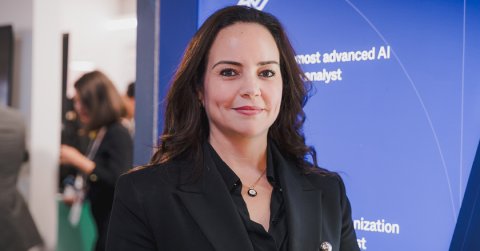
Meriam ElOuazzani discusses how Singularity Hyperautomation, AI SIEM, and Purple AI are revolutionising SecOps, enhancing threat detection, and addressing Middle East compliance challenges.
Meriam ElOuazzani, Senior Regional Director for META at SentinelOne, shares insights into how the company’s AI-driven innovations, including Singularity Hyperautomation, AI SIEM, and Purple AI, revolutionise cybersecurity operations, helping organisations improve threat detection, response times, and overall security efficiency.
ElOuazzani discussed the growing demand for automation in cybersecurity, the importance of data accuracy, and the role of AI in transforming non-specialists into proficient security analysts. At GISEC Global 2025, SentinelOne showcased its “Mortal vs. Machine” experience, demonstrating the power of AI in enhancing security operations.
Interview Excerpts:
Can you walk us through the launch of Singularity™ Hyperautomation, AI SIEM, and Purple AI, and how these innovations are transforming cybersecurity operations?
Over the past year, we’ve seen a significant shift in the approach from CIOs and CISOs who now come to us with a more defined understanding of their needs. Previously, they would approach us with interest in our XDR (Extended Detection and Response) solutions, but often without a specific focus on key areas like cloud features, identity management, or the application of AI and automation. This year, however, they are coming with a targeted mindset, seeking information on specific advancements in hyperautomation and related capabilities.
“Interest in Purple AI has also grown, with the technology now becoming a tangible reality. This shift has led to an increasing enthusiasm for integrating these innovations into cybersecurity strategies, enabling organisations to refine and enhance their security operations.”
How is AI revolutionising SecOps, and what impact is it having on organisations’ ability to detect and respond to threats more quickly and efficiently?
AI is fundamentally transforming SecOps by enhancing organisations’ ability to detect and respond to threats more swiftly and efficiently. From the outset, our company has integrated AI into detection, protection, and response, recognising that traditional signature-based approaches are no longer sufficient, especially given the prevalence of zero-day attacks. SentinelOne has consistently prioritised AI-driven solutions for detection and response, and we continue to enhance these capabilities with additional modules that increase the relevance and effectiveness of AI. A key advancement is the integration of AI into the way cybersecurity analysts interact with data. By enabling analysts to query data using simple language—similar to how one would interact with ChatGPT—we make the process of correlating and analysing data more intuitive. These queries are then translated into advanced queries in the backend, streamlining the investigative process. Moreover, the system allows analysts to save and share these queries in notebooks, fostering collaboration among team members. This collaborative feature not only promotes consistency across the team but also accelerates the adoption of our technology. Ultimately, the use of AI reduces detection and response times, while simplifying automation, making security operations more efficient and effective in today’s fast-paced threat landscape.
What are the key cybersecurity threats and compliance challenges organisations in the Middle East are facing, and how is the shift towards automation helping to address these issues?
Organisations in the Middle East are facing several key cybersecurity threats and compliance challenges, particularly around data accuracy, correlation, and the integration of data into a single platform. While automation plays a crucial role in addressing these challenges, it is essential that the data feeding into AI models is properly formatted, accurate, and up-to-date. Without proper data training and ingestion, the potential for incorrect interpretations increases, leading to lower-quality results. Automation remains a central focus in organisations’ cybersecurity strategies, making it crucial to not only emphasise its role but also address the need for robust data correlation and accuracy.
“By ensuring that data from multiple sources is properly integrated and queried through a unified platform, organisations can enhance the quality of their security operations and improve their ability to detect and respond to threats more effectively. Automation, combined with accurate data, is essential for organisations to meet the growing demands of cybersecurity while navigating the complexities of compliance.”
With the growing need for autonomous security, how does SentinelOne’s AI-driven threat detection and unified protection help organisations secure their infrastructure, and can you explain the “Mortal vs. Machine” experience at GISEC Global 2025?
SentinelOne’s AI-driven threat detection and unified protection offer organisations an autonomous approach to securing their infrastructure. The system analyses data to detect anomalies or malicious activity, automatically identifying threats without human intervention. This allows for rapid detection and response, significantly reducing the time and resources required for manual monitoring. At GISEC Global 2025, the “Mortal vs. Machine” experience aims to demonstrate the power of AI in transforming individuals into advanced security specialists. By leveraging AI tools, even someone with no prior cybersecurity knowledge can query data in plain English. The system then translates these queries into advanced queries in the backend, providing detailed threat-hunting results. This hands-on experience shows how AI can empower non-specialists, turning them into proficient analysts capable of identifying and responding to cyber threats effectively.


